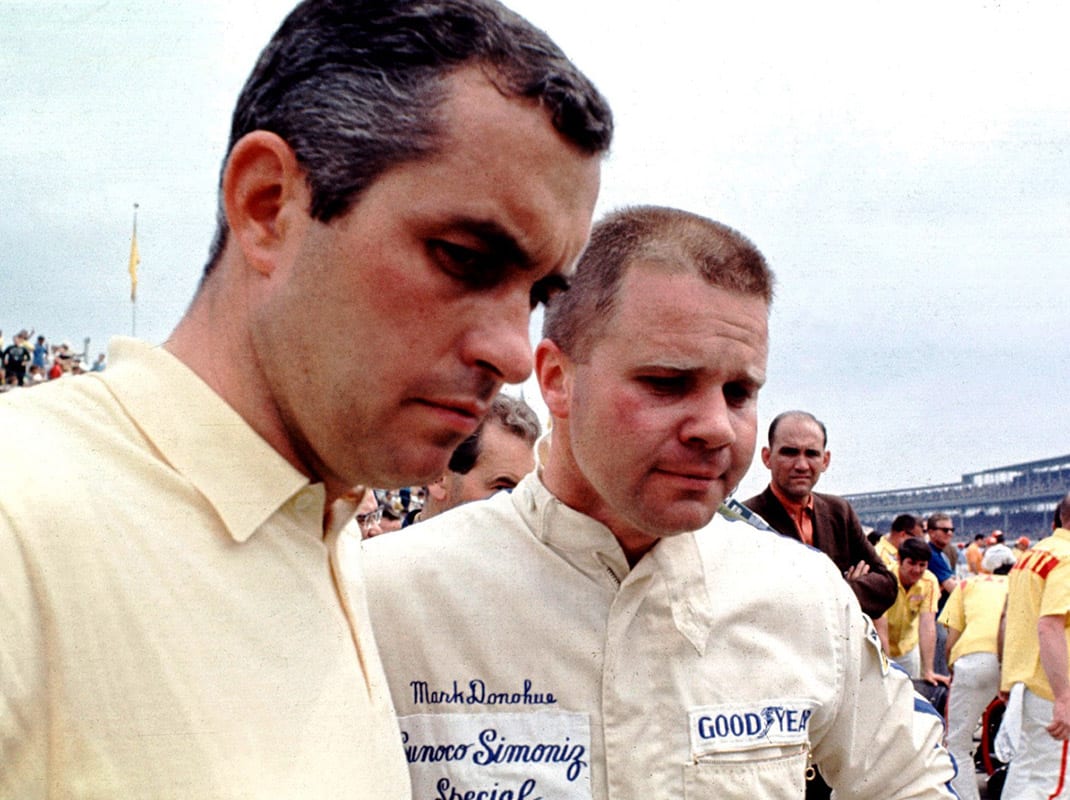In the aftermath of Monday’s announcement that Roger Penske was acquiring Indianapolis Motor Speedway and the NTT IndyCar Series, we present to our readers the story of Penske’s first Indianapolis 500 victory in 1972 with driver Mark Donohue.
Love him or hate him, and there are many on both sides of that equation, Roger Penske’s unprecedented success in the Indianapolis 500 deserves recognition.
Penske once considered driving Indy himself but turned his considerable energy to the car owner’s role instead. In 1969, he arrived at Indianapolis Motor Speedway for the first time with sports car racer Mark Donohue as his driver.
Penske in button-down shirts and the crew-cut wearing Brown University-educated Donohue were poles apart from drivers who’d dropped out of school to go racing and the best-dressed car owners who wore cowboy hats and boots.
Many in Indy car racing considered sports car racers a bit effeminate, but Penske soon quieted the skeptics by persistently practicing his life motto — effort equals result. Few were better prepared or more focused than Team Penske.
By his fourth year at Indianapolis, Penske had grown anxious for a victory. Chasing that goal, he surprised many by going outside the sports car ranks to add Gary Bettenhausen as a teammate to Donohue in 1972.
Bettenhausen was twice a USAC sprint car national champion. What he offered Penske was oval track savvy and the ability to setup a car for the unique nuances of oval racing.
Driving a pair of impeccably prepared, blue trimmed in yellow, Sunoco-sponsored McLarens, Bettenhausen and Donohue were consistently among the quickest during practice. On Pole Day, Donohue nabbed the third spot, while Bettenhausen qualified fourth.
In the days leading up to the race, most observers predicted a Penske driver would be the winner. Come race day, Bettenhausen assumed that role.
He took the lead on the 31st lap when polesitter Bobby Unser’s Eagle dropped out of the race. Bettenhausen soon left his closest competitors, Mike Mosley and Donohue, far behind.
Because he shouldered his legendary father’s incredible legacy (Tony Bettenhausen died attempting to win the 500), Gary Bettenhausen was the sentimental favorite. He dominated, leading 138 laps. But as it appeared a Bettenhausen image might finally appear on the Borg-Warner Trophy, he rolled to a stop.
A collective moan went up from the crowd.
“It was heartbreaking,” admitted Bettenhausen. “But 40 laps in I knew we were in trouble. The engine was overheating. I radioed Roger and he said, ‘Run it till it won’t run, Pal!’
“So I got out front, thinking I could at least win some of the lap prize money,” Bettenhausen added. “I tried a trick I’d learned racing sprint cars. At the end of the straights, I’d hit the kill button with the throttle wide open. The fuel flooded the valves and pistons and cooled it. Doing that, the temperature stayed down around 200 degrees.
“It just kept running, and I thought, ‘My family has tried to win this race for so long, maybe it’s finally going to happen,’” Bettenhausen said. “Then the yellow came out with 18 laps to go, and it was all over. Running that slow I couldn’t keep it cool and the engine seized.”
Bettenhausen remembered the crowd’s support helped assuage his disappointment. One group leaped the fence and surrounded him as he coasted to a stop.
“I bet I was handed 15 beers,” he laughed. “I climbed out of the car and sat there with those guys, drank some beer and watched the race.”
What Bettenhausen saw was Donohue charging after leader Jerry Grant, who was delivering a surprising run in Dan Gurney’s “Mystery Eagle.”
Donohue was gaining rapidly on Grant, but when Grant dove into the pits with a worn right-front tire, Donohue drove on to Penske’s first Indy 500 victory.
Donohue, typically gracious, said it should’ve been Bettenhausen’s victory. But Donohue’s victory was well deserved and made up for the 500 he should’ve won the previous year.
Much has changed since 1972. Gary Bettenhausen died in 2014 without winning at Indy. Donohue died driving a Penske Formula One car in 1975.
One thing that hasn’t changed is Penske’s love for the Indianapolis 500 and his intense desire to win the world’s greatest race.
And his creed, effort equals results, is still very much in play.
